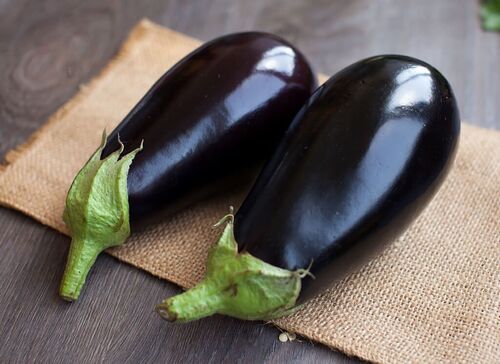Growing Eggplants

Aubergine ( or eggplant ) is believed to have been domesticated in the Old World, likely India, China, Thailand, Burma or someplace else in southeast Asia. Today there are approximately 15-20 different varieties of aubergine, grown primarily in China.
Sowing aubergines
Starting seeds indoors is most common, although if you live in an extremely warm, humid region, planting aubergine seeds directly in the garden may work.
Go direct to the aubergine seeds >
When starting your aubergine seeds indoors, be sure you have an area to germinate them that is quite warm, 80-90 F. (26-32 C.). Aubergine seed planting should occur four to six weeks before your last frost date. Although aubergine seeds are tiny, sow the seeds about ¼-inch (6 mm.) deep with good quality potting soil in flats or cell containers.
Fertilizer
At optimal conditions, the growing aubergine seeds should germinate within seven days. Two weeks after germination, fertilize the seedlings once a week with a soluble fertilizer — 1 tablespoon (15 ml.) of fertilizer to one gallon (4 L.) of water.
Planting out aubergine
Aubergine seedlings will be ready to transplant in six to eight weeks. Harden off the seedlings carefully by gradually reducing ambient temps and easing off on watering. Wait until the weather has settled, with no chance of frost and the soil is warm before transplanting. Cool temperatures will weaken the plants, and frost will kill them.
Once your aubergine seedlings are ready to move outdoors, choose a full sun area with a soil pH of 5.5 to 7.0 (acidic to neutral). Transplants should be set about 18-24 inches (45-60 cm.) apart in rows 30-36 inches (75-90 cm.) apart.
Watering aubergines
Aubergines need consistent watering of at least 1 inch every week, especially seedlings. Rather than giving your aubergines several short waterings per week, it’s better to provide one thorough soaking that reaches 6 inches into the soil. This encourages the aubergine roots to grow deep into the soil.
Try not to over-water your aubergines because it can cause fungus and disease. On the other hand, short, frequent watering makes your aubergines develop shallow roots that dry out quickly, and yellow leaves develop.
Health benefits of aubergine
- Aubergines contain a good amount of vitamins, minerals and fiber in few calories.
- In addition to containing a variety of vitamins and minerals, aubergines boast a high number of antioxidants. Antioxidants are substances that help protect the body from damage caused by harmful substances known as free radicals
- Thanks to their antioxidant content, some studies suggest that aubergines may help reduce the risk of heart disease.
- Aubergines are high in fiber and polyphenols, both of which may help reduce blood sugar levels.
- Aubergines are low in calories, making them an excellent addition to any weight loss regimen.
When to Harvest aubergines
- Harvest aubergines when they are firm and glossy and big enough to eat, about one third their maximum size.
- To test aubergine fruit for maturity, press the fruit with your thumb, if the flesh springs back it’s green and not ripe. If your thumb leaves an indentation, the fruit is overripe. The best tasting aubergine will be in between.
- A just ripe aubergine when sliced will have soft, well-formed but immature seeds. An immature and unripe aubergine will have no visible seeds. An overripe eggplant will have hard, dark seeds. (Seeds forming inside the fruit cause the skin to go from shiny to dull.) Both an under-ripe and overripe aubergine will be bitter tasting.
It is better to harvest aubergine just before its ripe than to wait too long.
How to Harvest aubergines
- Cut aubergine fruits from the plant with a garden pruner or sharp knife. Leave one inch of green stem attached to the fruit.
- Aubergines are very difficult to pull away from the plant by hand, doing so can damage the plant.
Aubergine seeds in our range
We have 6 varieties aubergine seeds in our range:



